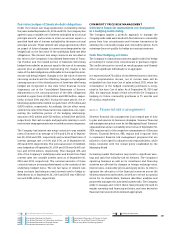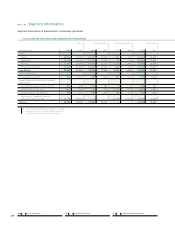Siemens 2014 Annual Report Download - page 302
Download and view the complete annual report
Please find page 302 of the 2014 Siemens annual report below. You can navigate through the pages in the report by either clicking on the pages listed below, or by using the keyword search tool below to find specific information within the annual report.
108 A. To our Shareholders 131 B. Corporate Governance 171 C. Combined Management Report
Within the various methodologies to analyze and manage risk,
Siemens has implemented a system based on parametric vari-
ance-covariance Value at Risk (VaR). The VaR methodology pro-
vides a quantification of market risks based on historical vola-
tilities and correlations of the different risk factors under the
assumptions of the parametric variance-covariance Value at
Risk model. The VaR figures are calculated based on
> historical volatilities and correlations,
> a ten day holding period, and
> a . % confidence level
for foreign currency exchange rate risk, interest rate risk,
commodity price risk and equity price risk as discussed below.
Actual results that are included in the Consolidated Statements
of Income or Consolidated Statements of Comprehensive
Income may differ substantially from VaR figures due to funda-
mental conceptual differences. The Consolidated Statements
of Income and Consolidated Statements of Comprehensive
Income are prepared in accordance with IFRS. The VaR figures
are the output of a model with a purely financial perspective
and represent the potential financial loss which will not be
exceeded within ten days with a probability of . %. The
concept of VaR is also used for internal management of the
Corporate Treasury activities.
Although VaR is an important tool for measuring market risk,
the assumptions on which the model is based give rise to
some limitations including the following. A ten day holding
period assumes that it is possible to dispose of the underlying
positions within this period. While this is considered to be a
realistic assumption in almost all cases, it may not be valid
during prolonged periods of severe market illiquidity. A . %
confidence level does not reflect losses that may occur beyond
this level. There is a . % statistical probability that losses
could exceed the calculated VaR. The use of historical data as
a basis for estimating the statistic behavior of the relevant
markets and finally determining the possible range of the
future outcomes on the basis of this statistic behavior may
not always cover all possible scenarios, especially those of an
exceptional nature. Any market sensitive instruments, including
equity and interest bearing investments, that our Company’s
pension plans hold are not included in the following quantita-
tive and qualitative disclosures.
FOREIGN CURRENCY EXCHANGE RATE RISK
Transaction risk and foreign currency
exchange rate risk management
Siemens’ international operations expose the Company to
foreign currency exchange rate risks, particularly regarding
fluctuations between the U.S. dollar and the euro, in the ordi-
nary course of business. The Company employs various strate-
gies discussed below involving the use of derivative financial
instruments to mitigate or eliminate certain of those exposures.
Foreign currency exchange rate fluctuations may create un-
wanted and unpredictable earnings and cash flow volatility.
Each Siemens unit conducting businesses with international
counterparties leading to future cash flows denominated in a
currency other than its functional currency is exposed to risks
from changes in foreign currency exchange rates. Foreign cur-
rency exchange rate exposure is partly balanced by purchasing
of goods, commodities and services in the respective curren-
cies as well as production activities and other contributions
along the value chain in the local markets.
Operating units (total Sectors and SFS) are prohibited from
borrowing or investing in foreign currencies on a speculative
basis. Intercompany financing or investments of operating
units are preferably carried out in their functional currency or
on a hedged basis.
Siemens has established a foreign currency exchange rate risk
management system that has an established track record for
years. Each Siemens unit is responsible for recording, assess-
ing, monitoring, reporting and hedging its foreign currency
transaction exposure. The binding guideline for Siemens’ oper-
ating units provides the concept for the identification and
determination of a single net foreign currency position for each
affected unit and commits these units to hedge this aggregated
position within a narrow band of at least % but no more than
% of their net foreign currency position. In addition, the
guideline provides a framework of the organizational structure
necessary for foreign currency exchange rate risk management,
proposes hedging strategies and defines the hedging instru-
ments available to the entities: foreign currency exchange
contracts, foreign currency put and call options and stop-loss
orders. If there are no conflicting country specific regulations,
hedging activities of the operating units are transacted inter-
nally with Corporate Treasury. Hedging transactions with exter-
nal counterparties in the global financial markets are carried
out under these limitations by Corporate Treasury. This includes
hedging instruments which qualify for hedge accounting.
























